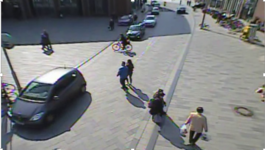
Deep Learning of User Behavior in Shared Spaces

Project idea: Modeling mixed traffic trajectories with collision avoidance in shared spaces using deep learning approaches
In shared spaces, road signs, signals, and markings are removed to allow mixed traffic---pedestrians, cyclists, and vehicles---directly interact with each other. This alternative traffic design aims at encouraging pedestrian movement and reducing the dominance of vehicles without explicit traffic rules. Consequently, all road users have to follow informal social protocols and negotiation to use the road resources, and avoid any potential collisions for safe traveling. At a micro level, understanding how they behave and how we can foresee their behavior after a short observation time are crucial to intent detection and autonomous driving, and traffic management in shared spaces.
Nevertheless, due to heterogeneity of transport modes, dynamic environments and space layouts, and various demographic attributes (e.g., age, gender, time pressure) of road users, modeling mixed traffic in shared spaces is of great challenge. The existing models (i.e., Social Force) initially designed only for pedestrian locomotion may not be sufficient for this purpose. In order to tackle the challenge, in this project, data driving approaches, particularly, deep learning neural networks are employed to build flexible and robust models for mixed traffic trajectory prediction with collision avoidance. Road user behavior is derived from observations of real traffic situations for learning their behavior patterns. Deep learning models are trained by such real—world traffic data. Then, the trained models are utilized for trajectory prediction in real—world situations.
The objectives of this project are: (a) modeling various realistic mixed traffic situations in shared spaces with divergent layouts and contexts; (b) leveraging an offline training and tuning framework and an online (real—time) prediction; (c) providing a solution for intent detection and on-board alarming system for autonomous driving in shared spaces.
Predictions of trajectories by the aforementioned models are compared with true trajectories observed from real traffic situations in terms of, for example, displacement errors, travel speed, and heading directions. Their performance is also compared against the state-of-the-art approaches.
Researcher: Hao Cheng, M.Sc.